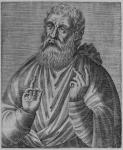Κατηγορία: Φιλοσοφικές θεωρίες
The Myth of the Cave
In the start of the seventh book of the Republic (514a-517a) Socrates recounts a myth designed to elucidate Plato’s Theory of Ideas, the ontological supremacy of the Good, and the necessity of combining political power with philosophical knowledge in an ideal state.
This myth, which is perhaps most accurately characterized as an allegory, describes a cave in which people have been living in shackles from birth, forced to gaze into the murky depths, where they can only discern shadows and hear echoes. Behind them, at the back of a low wall like that used by miracle-workers people carry wooden and stone effigies of men and animals, at the same time making the appropriate sounds. The light from a fire behind the low wall casts shadows of these objects on the cave’s walls, while the sounds, being reflected, appear to originate from these shadows. Being accustomed to such sights and sounds, the prisoners believe all these things to be real.
If one of them was freed and initially made to wander around the cave, then to exit it, it is clear that -according to Socrates- he would be able to clearly perceive what is real and what is not. Naturally, adjusting one's eyesight to the light coming from the fire, to the light of day, and especially to the blinding radiance of the sun would be a painful process at first. But it would eventually afford the rapture of complete, full knowledge. Obviously such a freed person would never wish to return to that cave. But if he was forced to do so, the rest of the prisoners would think that leaving the cave is hazardous for their eyesight, for he would no longer be able to clearly perceive the shadows. In fact, the captives would even attempt to murder him, if he attempted to free them and lead them to the light.
There are four discrete stages in the Allegory of the Cave: a) the state of the chained captives, reflecting the condition of humanity on the whole, as we are familiar with it from experience; b) the liberation of one individual inside the cave, which marks the start of the philosopher’s dissociation from the falsehood of sensory experience; c) the exit from the cave, which completes the lifting of the illusion and provides true knowledge of the principles of reality, i.e. Plato’s Ideas, at the pinnacle of which stands the Good (= the Sun in the myth); and d) the mandatory return to the cave, which reveals the need for a direct link between political action and philosophical knowledge.
In the way Socrates explains the allegory (517b-521c), a true philosophical education would involve developing man’s inherent potential and turning (περιαγωγή) the soul to superior concerns, away from everyday mundane things. The political message of the allegory is that if and only if philosophers are forced to rule will society be able to improve as a whole.
Because of its transparency, the Allegory of the Cave is used as a starting point in several layman works on Plato’s thought and philosophy in general. It has also inspired several authors and artists over the centuries. A typical example of its influence on the contemporary entertainment industry is the award-winning sci-fi film trilogy, The Matrix (1999-2003).
 Eλληνικά
Eλληνικά English
English



